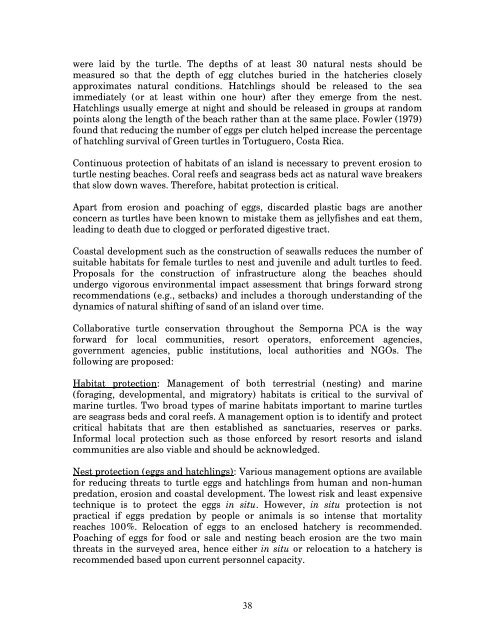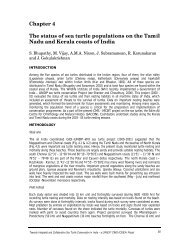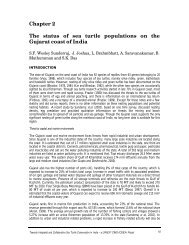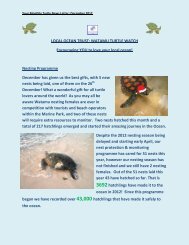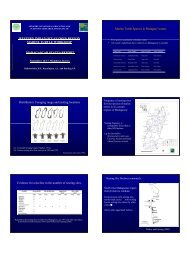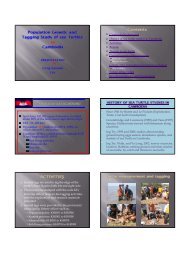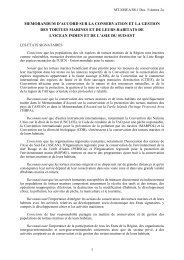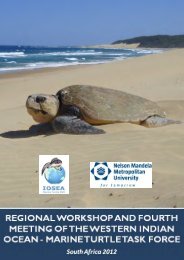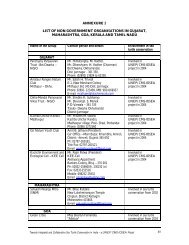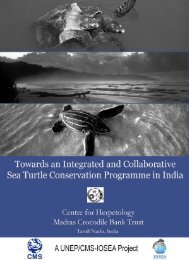Marine Turtle status Report - Indian Ocean - South-East Asian ...
Marine Turtle status Report - Indian Ocean - South-East Asian ...
Marine Turtle status Report - Indian Ocean - South-East Asian ...
Create successful ePaper yourself
Turn your PDF publications into a flip-book with our unique Google optimized e-Paper software.
were laid by the turtle. The depths of at least 30 natural nests should bemeasured so that the depth of egg clutches buried in the hatcheries closelyapproximates natural conditions. Hatchlings should be released to the seaimmediately (or at least within one hour) after they emerge from the nest.Hatchlings usually emerge at night and should be released in groups at randompoints along the length of the beach rather than at the same place. Fowler (1979)found that reducing the number of eggs per clutch helped increase the percentageof hatchling survival of Green turtles in Tortuguero, Costa Rica.Continuous protection of habitats of an island is necessary to prevent erosion toturtle nesting beaches. Coral reefs and seagrass beds act as natural wave breakersthat slow down waves. Therefore, habitat protection is critical.Apart from erosion and poaching of eggs, discarded plastic bags are anotherconcern as turtles have been known to mistake them as jellyfishes and eat them,leading to death due to clogged or perforated digestive tract.Coastal development such as the construction of seawalls reduces the number ofsuitable habitats for female turtles to nest and juvenile and adult turtles to feed.Proposals for the construction of infrastructure along the beaches shouldundergo vigorous environmental impact assessment that brings forward strongrecommendations (e.g., setbacks) and includes a thorough understanding of thedynamics of natural shifting of sand of an island over time.Collaborative turtle conservation throughout the Semporna PCA is the wayforward for local communities, resort operators, enforcement agencies,government agencies, public institutions, local authorities and NGOs. Thefollowing are proposed:Habitat protection: Management of both terrestrial (nesting) and marine(foraging, developmental, and migratory) habitats is critical to the survival ofmarine turtles. Two broad types of marine habitats important to marine turtlesare seagrass beds and coral reefs. A management option is to identify and protectcritical habitats that are then established as sanctuaries, reserves or parks.Informal local protection such as those enforced by resort resorts and islandcommunities are also viable and should be acknowledged.Nest protection (eggs and hatchlings): Various management options are availablefor reducing threats to turtle eggs and hatchlings from human and non-humanpredation, erosion and coastal development. The lowest risk and least expensivetechnique is to protect the eggs in situ. However, in situ protection is notpractical if eggs predation by people or animals is so intense that mortalityreaches 100%. Relocation of eggs to an enclosed hatchery is recommended.Poaching of eggs for food or sale and nesting beach erosion are the two mainthreats in the surveyed area, hence either in situ or relocation to a hatchery isrecommended based upon current personnel capacity.38


